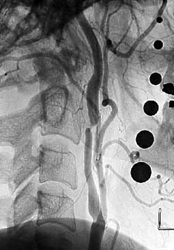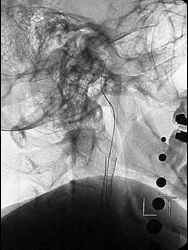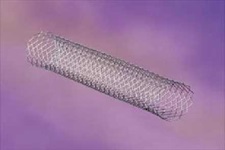

Narrowing of the carotid artery is most commonly caused by gradual cholesterol buildup called atherosclerosis. Other potential causes include carotid artery dissection, which is a tearing of the blood vessel wall that, if severe enough, can result in stroke. The most common method of treating a narrowed carotid artery is a procedure called carotid endarterectomy in which a surgeon makes an incision into the artery at the site of narrowing and removes the cholesterol plaque. This effectively restores the vessel to normal size.
Carotid angioplasty and stenting is a relatively new method of treating narrowing of the carotid arteries. This involves placement of a catheter in the groin and threading it into the carotid artery. A small wire is placed across the area of narrowing under X-ray guidance. At this point, a small angioplasty balloon may be expanded across the narrowing or a small metal tube called a stent can be deployed. At Emory, angioplasty and stenting are primarily used for those patients who are unable to undergo surgery.

The image above demonstrates a stent in the process of being deployed. After the proper position of the stent is confirmed, it is deployed to help keep the blood vessel open.
 This is what a stent looks like after it has been fully deployed.
This is what a stent looks like after it has been fully deployed.

